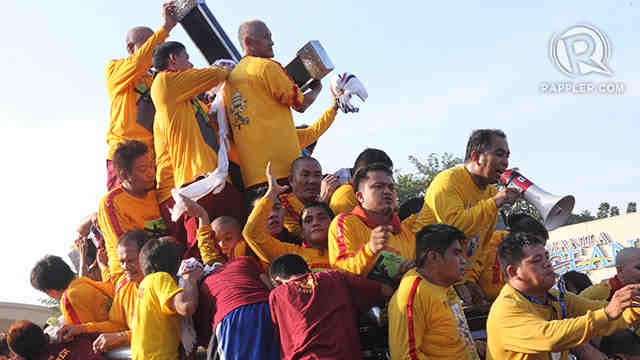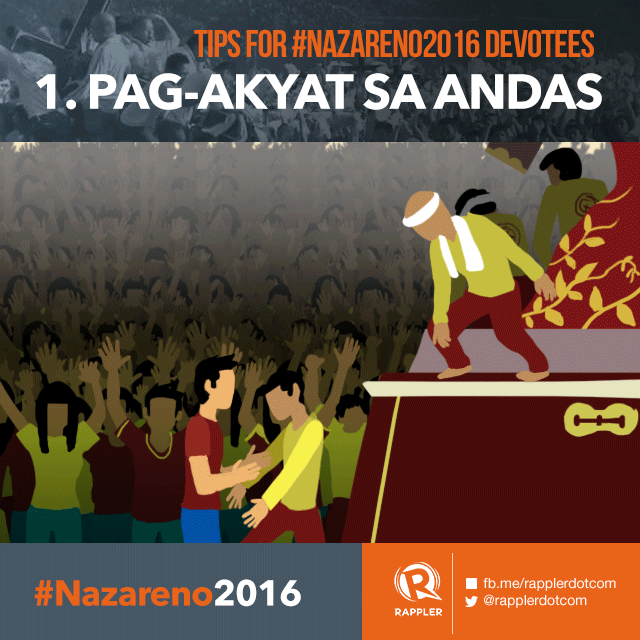SUMMARY
This is AI generated summarization, which may have errors. For context, always refer to the full article.

MANILA, Philippines – (UPDATED) From a bigger perspective, the Feast of the Black Nazarene looks chaotic at best – with millions of barefoot men and women wrestling towards the life-sized, mulatto image of Jesus Christ to fulfill their individual panata or vow.
But for Martin Aguda Jr, a crowd management and public safety consultant, the Traslacion, or the return of the Black Nazarene to the Minor Basilica, can actually be likened to a dance – with unique choreography established and practiced by its devotees.
“As someone who has experience with crowd management, I’ve learned that they have their own moves, they have their own choreography. However, it doesn’t exempt the event from problems that may occur,” Aguda said in a mix of Filipino and English.
Choreography

Up to 8 million devotees join the annual procession where the Black Nazarene, believed to perform miracles, is transported through Manila’s maze of streets.
Authorities also prepare for any possible scenario that may come up during the procession – classified by the government as a “high density population gathering.”
Devotees have two objectives: to get on board the carriage of the Black Nazarene or touch the rope attached to it.
During an orientation, the Hijos del Nazareno demonstrated the techniques to achieve these objectives. The Hijos are responsible for securing and transporting the Black Nazarene during the procession.
“May technique para sumampa sa taas: tuhod, balikat, tapos hihilahin ka sa taas. Kung bababa ka na, papalakpak ka, just to get the attention dun sa baba. And then, sasaluhin ka nung nasa baba,” Aguda explained.
(There is a technique to reach the statue: knee, shoulder, and somebody pulls you upward. If you are going down the carriage, clap to get the attention of those below, who would then catch you.)
The Hijos del Nazareno also shared the “choreography” for those who want to hold the rope.
“May technique na hahawakan mo yung gilid o likod nila tapos, ipupush nung nasa likod yung nasa harap niya para makasingit ka,” Aguda said.
(There’s a technique where you hold the side or back of the person in front of you, then he or she will push the person in front of him or her, so you can pass.)
Crowd management
The so-called choreography, however, does not exempt the religious activity from possible accidents or stampedes.
According to Aguda, there are two kinds of movement: panic (movement away from an object), or craze (movement towards an object). In this case, the Traslacion is an example of a craze scenario.

“If I am to analyze the Translacion, it’s actually a craze scenario… Based on science, delikado talaga ‘yan (it’s really dangerous),” he said.
Aguda explained that the Traslacion has two elements of a stampede: a tightly packed crowd and movement. He described a tightly packed crowd as a situation where there are up to 7 people per square meter.
“Masikip yun. Wala ka nang front and back space. Yung shoulders niyo will be brushing each other. ‘Di ka na maka-turn around. Puro ulo na lang makikita mo,” he added.
(That’s congested. There’s no more space in front of you and behind you. Your shoulders will be brushing each other. You won’t be able to turn around. All you’ll be seeing are people’s heads.)
Reminders
To be able to efficiently manage the crowd, Aguda said that it is not enough to learn the dance. Devotees – both old and new – should also condition themselves mentally and physically.
In 2015, the PRC recorded two deaths, and 1,727 devotees who were treated for minor and major injuries. In 2014, no fatalities were recorded.
To prevent injuries at the event, Manila Disaster Risk Reduction and Management Council head Johnny Yu shared the following tips for people planning to attend the Feast of the Black Nazarene:
- Bring appropriate personal medicines and water.
- Bring an ID card with the following information: emergency numbers, blood type, address, blood type.
- Don’t bring small children, senior citizens, and persons with disabilities along the procession route.
- Be aware of pickpockets.
- Know the nearest police station, first aid station, and hospital.
- Wear appropriate clothes.
– Rappler.com
Add a comment
How does this make you feel?
There are no comments yet. Add your comment to start the conversation.